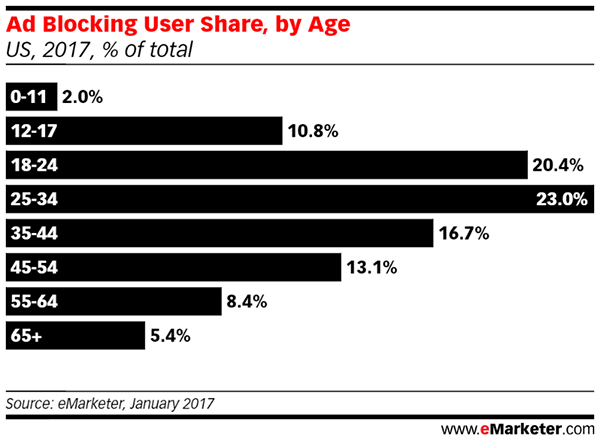With a rise in digital ad blocking users, how can digital advertising remain competitive? While digital ad spending has increased by 15.9%, ad blocking has grown at an even faster rate of 16.2%. Though an increase in spending is one way to compensate for more frequency, strategic audience planning might be a better fit for your business needs.
Who uses ad blockers?
Knowing who’s using ad blockers will allow your brand to better understand where your target audience falls within this emerging trend. Millennials make up the majority of ad block users, followed by Gen-X and Baby Boomers. This information can be extremely important based on where your audience falls.

For example, if you’re targeting adults 55+, you probably don’t need to worry about ad blockers as this audience accounts for the lowest ad blocking segments among adults 18+. However, if you’re targeting adults 18-34, who make up the largest share of ad blocking users, your online strategy might change based on campaign goals and budget.
Why use ad block software?
If you’re not one of the 75.1 million Americans using software to block ads, you might be wondering why people use it. Here are the top reasons US internet users block digital ads:
• Dislike large ads that pop-up full screen
• Ads increase the amount of time it takes for webpages to load
• Rollover ads are intrusive
• Audio autoplay can be intrusive
• Personalized ads based on data can be invasive
Knowing the reasons users are adopting ad blockers, advertisers need to be cognizant of a user’s online experience and plan for it accordingly. This starts with placement and ends with creative.
For example, if you’re looking for a unique way to place a call-to-action message, consider using push notifications. Asking users who visit your site to opt-in for the notifications can get around those pesky ad blockers, while giving you an authorized, direct communication channel to the consumer.
If you’re trying to show more than the written message allows, creative can produce non-intrusive media in different ways. For instance, rather than running ads that might interfere negatively with a user’s web browsing experience, creative could design a Snapchat geofilter that is interactive, sharable and noninvasive.
Where is ad block used?
Ad blocking software is primarily used on desktop computers. While it is possible to use ad blockers on smartphones, there’s only a 7.9% user penetration rate as opposed to desktops’ 20.1%. It may be true that targeting on desktops often leads to longer lead completions, but smartphones can be a much more powerful tool for combating ad blockers. If possible, make sure your campaign implements cross-device targeting, and always optimize your campaigns based on custom conversions as this is the best way to accurately track ROI.
Conclusion
Understanding who, where and why internet users are signing up for ad blockers can help digital advertisers think in a strategic way. Whether it’s using email ads, Snapchat geofilters, push notifications, or influencer marketing, there are ways of getting around the confines of ad blocking. Though many in the world of digital advertising have negative feelings towards ad blockers, they may be a small blessing in disguise. By understanding the obstacle they pose, advertisers can be pushed to think of more unique, creative, and non-invasive ways to reach consumers in an ever changing digital landscape.







